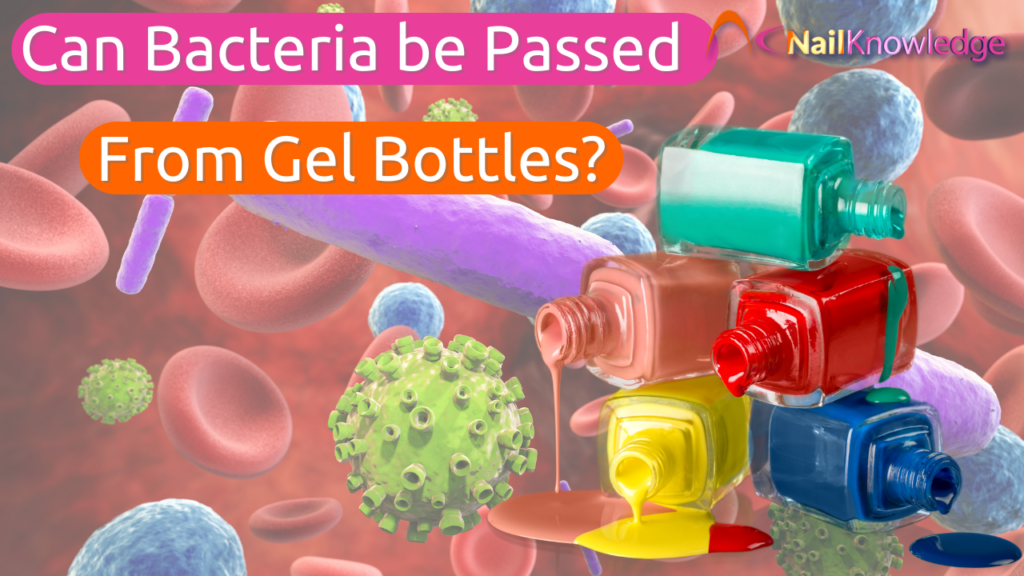When a client raises concerns about a potential nail infection following a gel manicure, it can feel both frustrating and worrying, especially when you know your hygiene standards are impeccable. A common question that arises in these situations is:
“Can bacteria be passed from gel polish bottles or brushes?”
Câu trả lời ngắn gọn là gì? It’s highly unlikely.
Nguy cơ nhiễm trùng từ chai gel và trách nhiệm nghề nghiệp
Let’s break this down step by step, exploring the science behind gel polish, infection risks, professional responsibility, and how to address client concerns with confidence.
1. Khoa học đằng sau Gel đánh bóng: Môi trường không thích hợp cho vi khuẩn
Gel polish is more than just a cosmetic product, it’s a carefully formulated chemical system. Its core ingredients, including ethyl methacrylate, isopropyl alcohol, and photoinitiators and more, tạo ra môi trường khiến vi khuẩn phải đấu tranh để tồn tại.
- Sức mạnh dung môi: The solvents in gel polish or standard polishes are inherently antimicrobial, meaning they kill or inhibit the growth of bacteria and other microorganisms.
- Nhúng đôi: When you dip a brush back into the gel bottle after applying polish to a client’s nails, any bacteria present on the brush would immediately encounter these solvents. Survival in such a chemical-rich environment is highly unlikely.
- Curing Process: Sau khi sơn, sơn gel sẽ được chiếu dưới tia UV hoặc đèn LED, giúp sản phẩm cứng lại và loại bỏ mọi khả năng phát triển của vi khuẩn.
Tóm lại: Chai sơn gel và cọ sơn không phải là nơi lý tưởng để vi khuẩn xâm nhập.
However, this is critical, as just because the product itself is inhospitable to bacteria doesn’t mean we can become complacent about hygiene standards or ignore nail health concerns.
2. Trách nhiệm nghề nghiệp của chúng tôi: Chỉ làm việc trên móng tay khỏe mạnh
As professional nail technicians, our duty extends beyond applying beautiful nails, it’s about protecting our clients’ health and wellbeing.
Chúng ta chỉ nên chăm sóc móng tay khi móng khỏe mạnh.
Nếu có bất kỳ nghi ngờ nào about the health of the client’s nails, be it signs of infection, trauma, or any abnormality, the safest and most professional action is to không tiếp tục dịch vụ và khuyên họ nên tìm lời khuyên y tế.
The assumption that “bacteria or pathogens won’t thrive in the bottle due to the chemicals, so it’s a risk that can be taken” is vô lý và vô trách nhiệm.
Vệ sinh luôn là ưu tiên hàng đầu:
- Mọi dụng cụ và bàn chải phải được vệ sinh và khử trùng hoặc xử lý theo đúng quy định.
- Workspaces must equally be kept disinfected and immaculate.
- Hands (both technician’s and client’s) must be properly sanitised before the beginning the service, and even at the end where possible.
- Bất kỳ bất thường nào về móng tay hoặc da đều phải dừng lại, đánh giá và nếu cần, phải giới thiệu đến chuyên gia chăm sóc sức khỏe.
Duy trì thực hành vệ sinh và chỉ làm việc trên móng tay khỏe mạnh giảm thiểu hoặc thậm chí loại bỏ nguy cơ nhiễm khuẩn, bất kể sản phẩm có thể không thân thiện với môi trường đến mức nào.
Nếu không phải là Gel, thì sao? Nguyên nhân phổ biến gây nhiễm trùng móng tay
While gel polish itself isn’t a likely culprit, nail infections can arise from other factors. Here are the most common causes:
- Sơn Gel chưa khô
If gel isn’t fully cured under UV/LED light, it can remain tacky and trap moisture—a potential breeding ground for bacteria and fungi. - Chuẩn bị móng không đúng cách
Skipping essential steps like cleansing and sanitising the nail plate before applying coatings can leave bacteria or fungi behind. - Công cụ bị ô nhiễm
Reusable tools that aren’t properly disinfected or sterilised can transfer bacteria or fungi from one client to another. - Nail Trauma or Damage
Over-filing, aggressive cuticle removal, or accidental nicks during the service can expose the nail bed and/or surrounding skin to opportunistic pathogens. - Điều kiện có sẵn
Clients who already have fungal infections or compromised nail health are naturally more prone to further complications. - Phản ứng dị ứng
Sometimes, what appears to be an infection might actually be an irritation or allergic reaction to one of the ingredients within the nail coating. - Chăm sóc sau kém
Những khách hàng để móng tiếp xúc với độ ẩm trong thời gian dài, với hóa chất độc hại hoặc bỏ qua lời khuyên chăm sóc sau khi làm móng có thể gặp các vấn đề về sức khỏe móng sau khi làm móng.
Mỗi yếu tố này có thể dẫn đến các triệu chứng như đỏ, sưng hoặc khó chịu, có thể giống như nhiễm trùng.
Cách giải quyết mối quan tâm của khách hàng một cách chuyên nghiệp
Handling these situations with professionalism, empathy, and education is key. Here’s how:
Bước 1: Xác nhận mối quan tâm của họ
Bắt đầu bằng cách cảm ơn khách hàng đã nêu vấn đề với bạn. Đảm bảo với họ rằng mối quan tâm của họ đang được giải quyết nghiêm túc.
Ví dụ:
“Thank you so much for letting me know about your concern. I take issues like this very seriously, and I want to make sure we address it together.”
Bước 2: Giáo dục với sự tự tin
Chia sẻ khoa học đằng sau chất đánh bóng và đặc tính kháng khuẩn của nó. Giải thích tại sao gel chưa đông cứng, tình trạng bệnh lý có từ trước hoặc các yếu tố khác là thủ phạm phổ biến hơn gây ra nhiễm trùng.
Ví dụ:
“Gel polish itself isn’t a hospitable environment for bacteria due to its chemical composition. However, infections can sometimes arise from other factors, such as trauma to the nail, pre-existing conditions, or aftercare habits.”
Bước 3: Cung cấp hỗ trợ và khuyến khích chẩn đoán y tế
If a client’s symptoms persist or worsen, it’s important they consult a healthcare professional for an accurate diagnosis.
Ví dụ:
“I’d recommend visiting a medical professional to confirm if there’s an infection and identify the exact cause. This will help us both understand what might have happened.”
Bước 4: Tăng cường tiêu chuẩn vệ sinh của bạn
Hãy tận dụng cơ hội này để trấn an khách hàng về cam kết của bạn đối với vấn đề vệ sinh và an toàn.
Ví dụ:
“In my salon, I follow strict hygiene protocols, including sterilising tools, sanitising workstations, and following manufacturer guidelines for all products.”
Suy nghĩ cuối cùng
Mặc dù lọ sơn gel và cọ không phải là nguồn lây nhiễm vi khuẩn nhưng nhiễm trùng vẫn có thể phát sinh từ những yếu tố khác.
Nhưng quan trọng hơn:
- Chúng ta không bao giờ được cho rằng rủi ro là có thể chấp nhận được chỉ vì sản phẩm có thể làm giảm rủi ro.
- Chúng tôi phải luôn duy trì các tiêu chuẩn cao nhất về vệ sinh và tính chuyên nghiệp.
- Chúng ta chỉ nên chăm sóc móng tay khỏe mạnh, không có ngoại lệ.
Cách tiếp cận này không chỉ đảm bảo an toàn cho khách hàng mà còn bảo vệ danh tiếng và uy tín nghề nghiệp của bạn.
Professionalism, education, and accountability are the cornerstones of our industry. Let’s continue to uphold them with pride.
Hãy luôn học hỏi và chuyên nghiệp.


